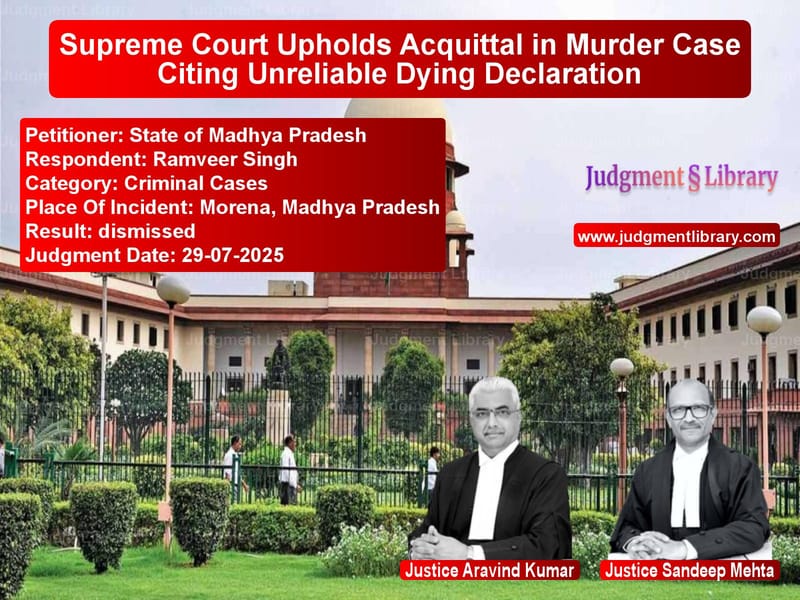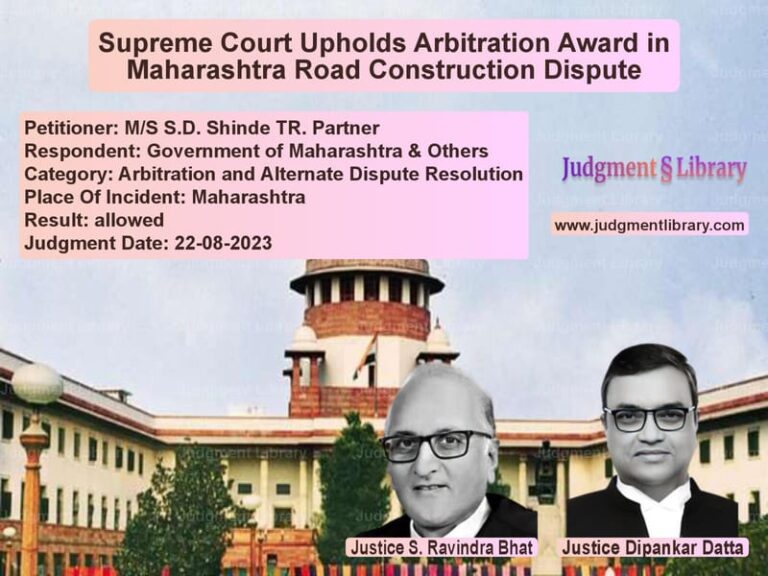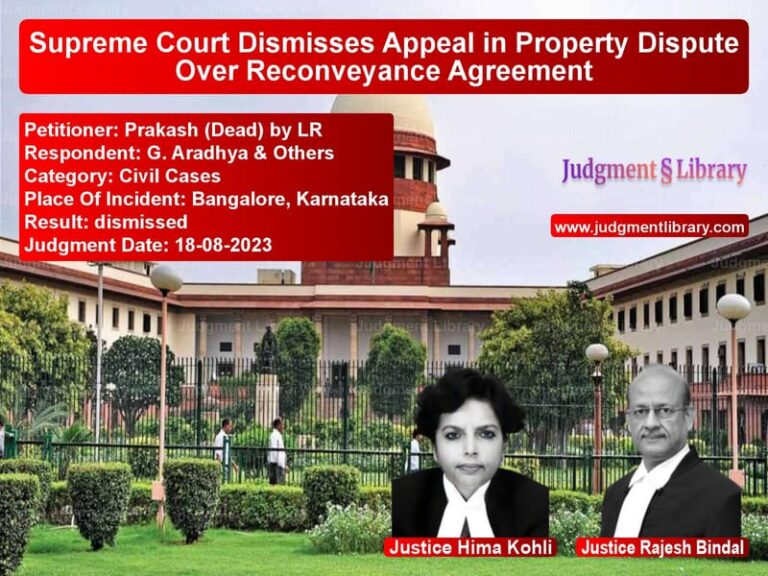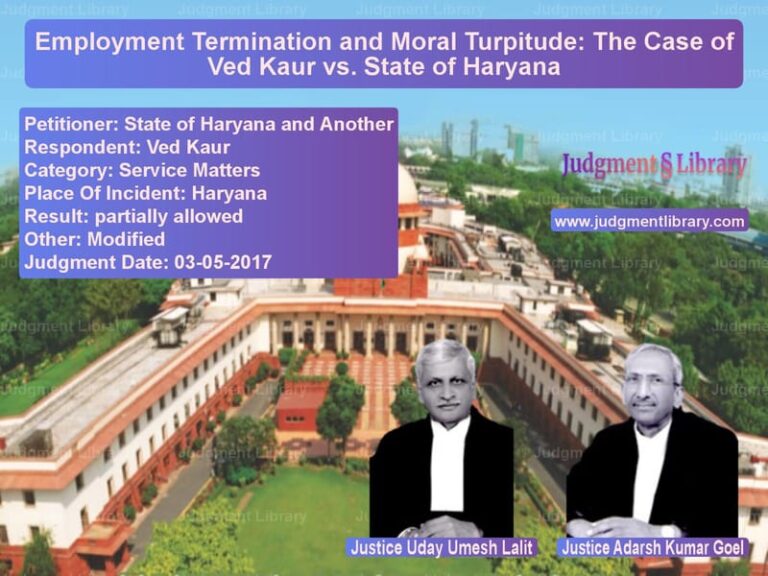Supreme Court Upholds Acquittal in Murder Case Citing Unreliable Dying Declaration
In a significant criminal appeal that underscores the importance of reliable evidence in capital cases, the Supreme Court of India has dismissed the State’s appeal and upheld the acquittal of an accused in a murder case, primarily due to serious doubts about the credibility of the dying declaration. The case of State of Madhya Pradesh versus Ramveer Singh, decided on July 30, 2025, involves a tragic incident where a young woman was set on fire, leading to her death. The legal battle spanned over two decades, moving from the trial court’s conviction to the High Court’s acquittal, and finally to the Supreme Court’s affirmation of the acquittal. This judgment highlights the critical legal principles governing dying declarations and the high standard of proof required in criminal cases, especially when the prosecution’s case rests substantially on such evidence.
The case originated from a horrific incident on March 10, 2003, when a dehati nalishi (rural report) was recorded by ASI Janved Singh based on the statement of Poona Bai. The prosecution alleged that at about 4:00 pm on that day, the accused-respondent Ramveer Singh forced his way into their house carrying a container of kerosene oil, poured it on the body of her grand-daughter Badami Bai, and set her on fire with the intention of killing her. According to the prosecution, the motive behind this brutal attack was rooted in an incident that had occurred twelve days prior, when Raju, the son of the accused-respondent, had allegedly committed rape upon the victim. The matter had been reported to the police by Ramveer Singh, the son of Poona Bai, and the accused-respondent bore a grudge for this complaint.
Based on Poona Bai’s statement, an FIR was registered against the accused-respondent at Police Station Dimni, Morena, for offences punishable under Sections 307 (attempt to murder) and 450 (house-trespass) of the Indian Penal Code, and Section 3(2)(v) of the Scheduled Castes and Scheduled Tribes (Prevention of Atrocities) Act, 1989. The victim, who had suffered severe burn injuries, was taken to the District Hospital in Morena for treatment. The prosecution claimed that the dying declaration of the victim was recorded by the Executive Magistrate/Naib Tehsildar, Anil Singh Raghav, at the hospital. Tragically, the victim succumbed to her burn injuries at about 8:30 pm, after which Section 302 (murder) of IPC was added to the case.
The accused-respondent was arrested, and after investigation, a chargesheet was filed against him. The case was committed to the Sessions Court and then transferred to the Special Court for trial. Charges were framed against the accused-respondent for offences punishable under Sections 302 and 449 of IPC and Section 3(2)(v) of the SC/ST Act. The accused pleaded not guilty and claimed trial. After recording evidence and hearing arguments, the trial court convicted the accused-respondent for offences under Sections 449 (house-trespass) and 302 (murder) of IPC but acquitted him of the charge under the SC/ST Act. The trial court sentenced him to rigorous imprisonment for 10 years under Section 449 IPC and life imprisonment under Section 302 IPC, along with fines.
The High Court’s Acquittal and Reasoning
The accused-respondent appealed against his conviction before the High Court of Madhya Pradesh at Gwalior. The High Court, in its judgment dated June 22, 2010, accepted the appeal and set aside the conviction, acquitting the accused-respondent of all charges. The High Court’s decision was based on several crucial findings that raised serious doubts about the prosecution’s case.
First, both the trial court and the High Court disbelieved Poona Bai’s claim of being an eye-witness to the incident. The trial court had recorded pertinent findings doubting her presence at the place of incident and discarded her testimony. The High Court affirmed this finding, stating that “Poona Bai (PW-10) did not witness the incident.” This was significant because apart from the dying declaration, Poona Bai’s testimony was the primary evidence linking the accused to the crime.
The High Court then extensively examined the dying declaration, which formed the bulwark of the prosecution’s case. The Court noted several critical flaws in the recording and reliability of the dying declaration. Naib Tehsildar (PW-8), who recorded the dying declaration, admitted in his cross-examination that “at the time of tendering the dying declaration, the victim was conscious and was able to answer the questions, but her voice was very feeble and not clear at all.” Furthermore, both the Naib Tehsildar and Dr. A.K. Gupta (PW-13) admitted that “they found it difficult to decipher the dialect in which the injured victim spoke.” The witness had to bend down to grasp whatever she was trying to say, indicating the extreme difficulty in understanding her statements.
The High Court also noted concerning evidence from Mango Bai (PW-12), who stated that “when the dying declaration was being recorded, she and her mother-in-law i.e., Poona Bai (PW-10) were present there and they told the concerned officer on behalf of the victim as to how the incident had taken place.” This raised the possibility that the dying declaration may not have been the victim’s own words but rather what others were telling the recording officer.
Medical evidence further weakened the prosecution’s case. The High Court noted that “the victim was having 100% burns and Dr. A.K. Gupta (PW-13) admitted that the general condition of the victim was extremely poor.” Most importantly, the Doctor admitted that “when the dying declaration was being recorded, neither the pulse nor the blood pressure of the victim were measurable” which convinced the High Court that “it was totally unsafe to rely on the dying declaration.”
The timing of the recording of the dying declaration also created doubts. The victim had been admitted to the hospital at 7:25 pm, the dehati nalishi was recorded, and the victim succumbed to death at 8:30 pm. This tight timeline made the entire sequence of events difficult to believe. Additionally, the High Court found that there was no reference to any oral dying declaration in the dehati nalishi lodged by Poona Bai, which created further doubt about the prosecution’s version.
The High Court also noted identification issues, as the complainant Poona Bai admitted that “there were several persons having the name Ramveer” creating serious doubt about whether the accused-respondent was the same Ramveer mentioned in the dying declaration. Furthermore, the prosecution had suppressed an earlier report taken from Poona Bai at the village, which was not brought on record.
Considering all these factors cumulatively, the High Court held that “the dying declaration was not free from doubt and hence, it would be hazardous to place reliance on the same for convicting the accused-respondent.” Since no other evidence connected the accused to the crime, the High Court acquitted him.
The Supreme Court’s Analysis and Final Decision
The State of Madhya Pradesh appealed against the acquittal to the Supreme Court. The Supreme Court, after hearing the arguments and examining the records, upheld the High Court’s decision to acquit the accused-respondent. The Court emphasized that this was an appeal against acquittal and recalled the well-settled legal principle that “in an appeal against acquittal unless the finding of acquittal is perverse on the face of the record and the only possible view based on the evidence is consistent with the guilt of the accused only in such an event, should the appellate Court interfere with a judgment of acquittal.” The Court further stated that “where two views are possible i.e., one consistent with the acquittal and the other holding the accused guilty, the appellate Court should refuse to interfere with the judgment of acquittal.”
The Supreme Court expressed “full agreement with the aforesaid observations and findings of the High Court” and was “of the firm view that the circumstances surrounding the recording of the dying declaration create a grave doubt making the said evidence unworthy of credence.” The Court specifically noted the medical evidence, stating that “on a perusal of the testimony of Dr. A.K. Gupta (PW-13), we are convinced that the victim was in such a precarious physical condition that it would have been virtually impossible for her to have narrated the story in the manner claimed by the prosecution.”
The Court highlighted the critical admission by the Doctor that “neither the pulse nor the blood pressure of the victim were recordable” and the Naib Tehsildar’s admission that “the victim’s voice was barely audible when he was trying to record the dying declaration.” Based on these facts, the Supreme Court concluded that “the very factum of recording of the dying declaration comes under a grave doubt making it totally unreliable.”
The Supreme Court ultimately held that “the present is not a case wherein it can be said that no view other than the guilt of the accused-respondent is possible.” The Court found that “the prosecution case is full of material contradictions and inherent improbabilities and there do not exist any valid or substantial reasons to interfere with the acquittal of the respondent as recorded by the High Court.” The appeal was therefore dismissed, and the acquittal was upheld.
This judgment reinforces the fundamental principle of criminal jurisprudence that the prosecution must prove its case beyond reasonable doubt and that when the evidence raises serious questions about its reliability, the benefit of doubt must go to the accused. The Supreme Court’s decision underscores the cautious approach courts must take when relying on dying declarations, especially in cases where the declarant’s physical and mental condition raises doubts about their ability to provide a coherent and reliable account of events.
Petitioner Name: State of Madhya Pradesh.Respondent Name: Ramveer Singh.Judgment By: Justice Aravind Kumar, Justice Sandeep Mehta.Place Of Incident: Morena, Madhya Pradesh.Judgment Date: 29-07-2025.Result: dismissed.
Don’t miss out on the full details! Download the complete judgment in PDF format below and gain valuable insights instantly!
Download Judgment: state-of-madhya-prad-vs-ramveer-singh-supreme-court-of-india-judgment-dated-29-07-2025.pdf
Directly Download Judgment: Directly download this Judgment
See all petitions in Murder Cases
See all petitions in Bail and Anticipatory Bail
See all petitions in Attempt to Murder Cases
See all petitions in Fraud and Forgery
See all petitions in Custodial Deaths and Police Misconduct
See all petitions in SC/ST Act Case
See all petitions in Judgment by Aravind Kumar
See all petitions in Judgment by Sandeep Mehta
See all petitions in dismissed
See all petitions in supreme court of India judgments July 2025
See all petitions in 2025 judgments
See all posts in Criminal Cases Category
See all allowed petitions in Criminal Cases Category
See all Dismissed petitions in Criminal Cases Category
See all partially allowed petitions in Criminal Cases Category







